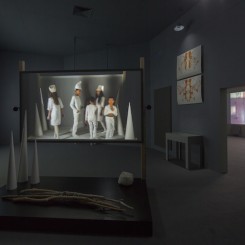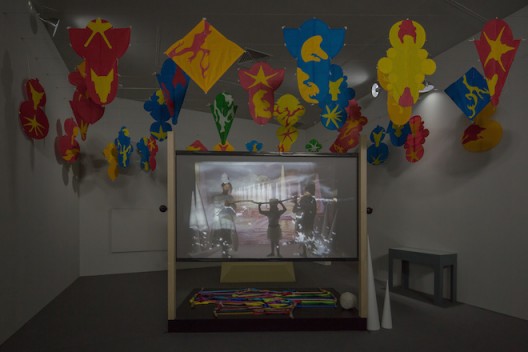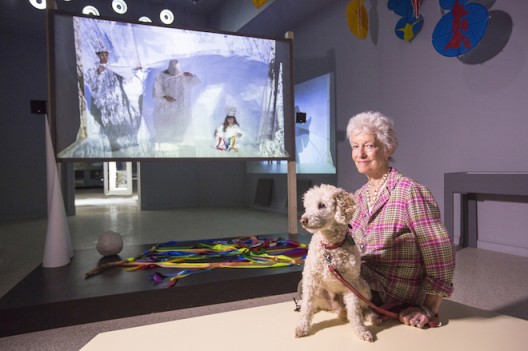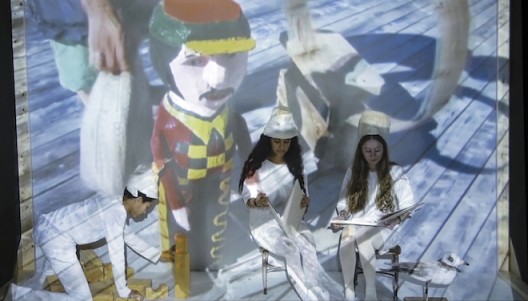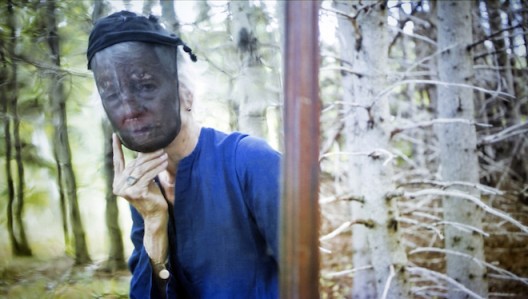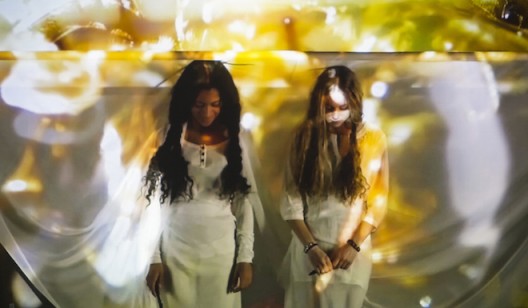“Joan Jonas: They Come to Us without a Word”
NTU Centre for Contemporary Art (Block 43 Malan Road Gillman Barracks Singapore 109443), Jan 22 — Apr 3, 2016
There is a question the exhibition’s co-curators Ute Meta Bauer and Paul C. Ha seem keen on provoking with this new edition (and subsequent editions) of Joan Jonas’ “They Come to Us without a Word”: What is site specificity, and how may it be translated? And: How does Jonas’ work shift and change—beyond such physical necessities of adapting to rooms of different sizes and shapes—between the US Pavilion of the 56th Venice Biennale, and a contemporary art institution, amid what was by many accounts a rather damp and tired Singapore Art Week?
In so doing, one might wonder at the coincidence of the MIT List Visual Arts Center and the NTU Centre for Contemporary Art Singapore (NTU CCA) both being visual art institutions as part of technological universities, or some connection between the mercantile history of Venice and Singapore’s position in trade and finance. Ha imagines Venice as a dying city of vanishing trades, much as the bees, fish, and mirror-makers Jonas discusses in the exhibition are in peril. This relation, then, between the exhibition and its host city rather hinges on how one perceives Singapore—as some shining smart-city upon a hill, a bureaucratic morass of gilded rot, or something in-between. It is not as if the exhibition needed extra layers of complexity and nuance, but it is certainly fun to think about.
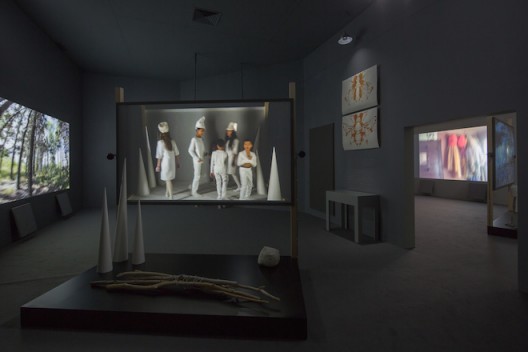
《琼·乔纳斯:他们悄然而至》, 展览场景/ “They Come to Us without a Word”, exhibition view. Courtesy of NTU CCA Singapore.
Contextual resonances aside, “They Come to Us without a Word” evokes themes and concerns that approach some sense of universality without the po-faced didacticism which would undermine such an effort. Major touchstones of the exhibition as a whole are those of fragility, loss, and various perspectives on grief. The exhibition is split across a number of thematically oriented rooms, each containing—with some variation—video-performances, props from the same, a selection of drawings, enigmatic hand-written quotations on the walls, and vitrines containing personal effects and artifacts which act, so to speak, as the seed-crystals of each room. The video-performances, as a whole, require a little more unpacking; they frequently involve groups of children reacting to the general theme of each room, spliced with numerous layers of somehow related footage. Each layer moves at odds with its fellows, yielding considerable disorientation.
The first two rooms concern themselves with bees and fish, respectively, tempting us to foreground an environmentalist perspective on the exhibition—the dangers we face as a result of Colony Collapse Disorder, or the effects of overfishing on marine ecosystems. The next room, however, complicates such a reading—each wall is covered with mirrors, a chandelier hangs from the ceiling, and a skewed projection plays across all four walls. Reflecting in on itself over and over, it rather feels as if Jonas is exploring what it might be like to live inside a television. Alternatively, we might take it as a pivot or border of sorts, with the subjects of the succeeding rooms being somewhat different in character.
“Wind” and “Homeroom” follow next. While the former could be linked to the threatened species in the previous rooms, via green energy and so on, the subject of the final room should suffice to dispel any notion of the exhibition being a straightforward piece of environmental activism. As a concept, “Homeroom” makes for a strange fit in Singapore, being something encountered almost exclusively in the media. What might be a familiar touchstone (the idea of “homeroom”) to some has, in the context of Singapore, the potential to compound and extend the overall strangeness of the exhibition..
A video in “Wind”, for instance, cements a certain sense of warm, playful irreverence that pervades the exhibition, despite the delicate layers of abstract theorization that could be laid on it. A camera barrel-rolling over and over, is trained on Jonas walking one of her dogs. It is as disorienting as it is delightfully absurd, as a counterpoint to another persistent element of the exhibition—fragmentary recordings of Nova Scotian ghost stories. These dry exclamations wind their way disjointedly through the space, eliciting anything from confusion to faint chills.
Likewise, the otherworldly music which flows seamlessly from room to room, along with the diffuse, silvery light—meant to evoke moonlight, and emanating from custom bulbs suggestive of science-fictional insects—speak of Jonas’ attention to detail in crafting a rich, varied, unsettling and yet heartening experience. Even when leaving the exhibition, passing through a curtain to the golden warmth of the gallery’s study room, you get a sense that Jonas’ dramaturgy is not quite finished, with that very action of leaving the main exhibition area being a part of her design. It is a moment of perceptual shock, blinking at the sudden, warm, light, that is both refreshing and unsettling, providing a definitive break with the phantasmagorical chambers of Jonas’ exhibition.
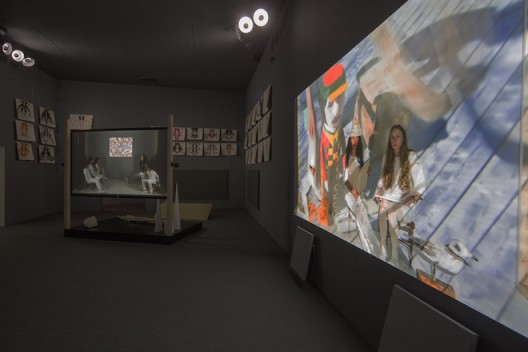
《琼·乔纳斯:他们悄然而至》, 展览场景/ “They Come to Us without a Word”, exhibition view. Courtesy of NTU CCA Singapore.
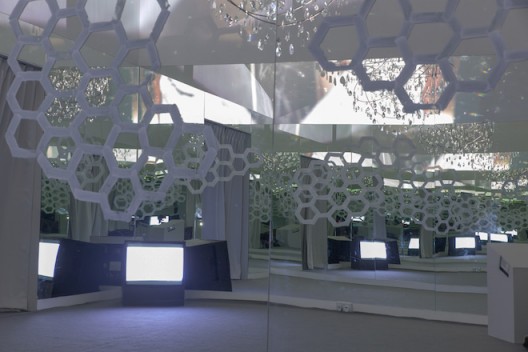
《琼·乔纳斯:他们悄然而至》, 展览场景/ “They Come to Us without a Word”, exhibition view. Courtesy of NTU CCA Singapore.
